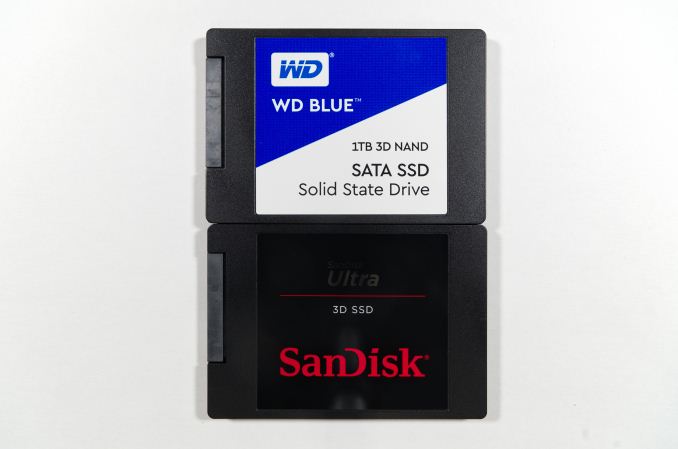One Design, Two Products: The SanDisk Ultra 3D (1TB) and WD Blue 3D (1TB) SSD Reviews, with BiCS 3D NAND
by Billy Tallis on September 14, 2017 9:00 AM ESTConclusion
Compared to last year's WD Blue that used planar TLC NAND flash, the new WD Blue 3D NAND and SanDisk Ultra 3D perform much better on tests where the older drive was weakest. At lower queue depths where the bandwidth of the SATA link was not a bottleneck, the new SSDs delivered significantly better random read and write performance than their predecessors. But the SATA bus has limited how much of a peak improvement 3D NAND could make for the raw performance of Western Digital's SSDs.
Compared to the competing drives on the market today, the new WD Blue 3D NAND and SanDisk Ultra 3D have the performance that is expected of a mainstream SATA SSD. On most real-world workloads, there's no noticeable performance difference between the Ultra 3D and the Samsung 850 EVO. The Ultra 3D also handles being full better than most TLC drives, and does not show the spike in latency that several drives like the Crucial MX300 exhibit. Overall, it is clear that SanDisk is still very good at managing TLC flash and implementing SLC caching in a way that has almost no downsides.
The switch to 3D NAND also brings substantial power savings to the WD Blue 3D NAND and SanDisk Ultra 3D. Idle power is unchanged from the previous generation of drives, but power draw under load is much lower.
| 240-275GB | 480-525GB | 960-1050GB | 2TB | |
| SanDisk Ultra 3D | $89.99 (36¢/GB) | $149.99 (30¢/GB) | $284.99 (29¢/GB) | $549.99 (28¢/GB) |
| WD Blue 3D NAND | $94.99 (38¢/GB) | $164.99 (33¢/GB) | $309.99 (31¢/GB) | $619.99 (31¢/GB) |
| Crucial BX300 | $89.99 (38¢/GB) | $149.99 (31¢/GB) | ||
| Crucial MX300 | $92.99 (34¢/GB) | $149.99 (29¢/GB) | $284.47 (27¢/GB) | $544.62 (27¢/GB) |
| ADATA SU800 | $91.99 (36¢/GB) | $154.99 (30¢/GB) | $269.99 (27¢/GB) | |
| Intel SSD 545s | $99.99 (39¢/GB) | $209.00 (41¢/GB) | ||
| Samsung 850 PRO | $104.99 (41¢/GB) | $209.09 (41¢/GB) | $406.00 (40¢/GB) | $859.99 (42¢/GB) |
| Samsung 850 EVO | $89.99 (36¢/GB) | $147.99 (30¢/GB) | $327.00 (33¢/GB) | $697.99 (35¢/GB) |
Current pricing for the Western Digital SSDs is a bit odd. The WD Blue 3D NAND is more expensive than the SanDisk Ultra 3D by several cents per GB despite the two products being the same under the sticker. The only reason to go with the WD Blue 3D NAND at the moment is for the M.2 version, since the SanDisk Ultra 3D is only available in the 2.5" form factor.
The SanDisk Ultra 3D is priced in between the Crucial MX300 and the Samsung 850 EVO. This matches their relative performance. The performance advantage of the 850 EVO is quite small for most real-world workloads, so its premium mostly buys you a longer warranty and the proven maturity of a product that has been on the market for a long time. If your workload is heavy enough for the difference between the 850 EVO and the Ultra 3D to matter, you should probably be shopping for a NVMe SSD instead of SATA. Meanwhile, the SanDisk Ultra 3D offers higher write endurance ratings and lower power consumption for a slightly lower price. The Ultra 3D makes more sense for most consumers.
Between the SanDisk Ultra 3D and the Crucial MX300, the Ultra 3D should be preferred for heavier workloads. The MX300 will get you an extra 25 or 50GB for the same price, but if you fill up the drive enough for that slightly higher capacity to come into play, the Ultra 3D will perform better. The MX300 still has the advantage in power efficiency and is the better pick for mobile use.
With a good balance of price, performance and power efficiency, the SanDisk Ultra 3D is an easy recommendation.













52 Comments
View All Comments
Foeketijn - Thursday, September 14, 2017 - link
We are talking about a Watt. Difference or so. Adding an extra fan has more impact. (Laptop? Who is upgrading a laptop with an 2,5" disk? Those are only found in really cheap devices anyway) The evo is known to just keep on going way way over that endurance point. How will these fare? We don't know yet. I think he has a fair point. There is no logical reason to choose this over a samsung other than not liking samsung. And samsung is just sitting there waiting till people notice their m2 driver are creaping to their sata prices. For a couple dollar more you get benchmarks that don't fit in these diagrams. I'm not a samsung fan. Just sad that no one is even trying to win this fight. The 850 evo is almost 3 years old and still on top for it's pricepoint (250Gb it is)mapesdhs - Thursday, September 14, 2017 - link
Indeed, so until I see tech akin to the 850 EVO come back down to the 55 UKP level for 250GB where it was at a couple of years ago, I just keep hunting for new or lighly used 840 Pro or other models via normal auction, bagged another 840 Pro 256GB recently for 51 UKP; would be fascinating to see how this model and others from previous generations of good SSDs would fare in these tests (Vertex4, Neutron GTX, Extreme Pro, Vector, etc.) Except for power consumption (who cares in a desktop), I doubt the latest models are that much better at all. I miss the days of buying an 850 EVO 500GB for 118 UKP (that was Oct/2015).Until then, there's better value in NVMe models with addin card adapters, eg. SM951.
Luckz - Wednesday, October 11, 2017 - link
When talking pound prices, it might be reasonable to mention how much your currency has changed since the 840 came out.Rictorhell - Thursday, September 14, 2017 - link
Hoping for someone, other than Samsung, to come up with a viable and somewhat affordable 4tb ssd, sata, or otherwise, so that prices at or near that capacity will become at least somewhat reasonable, someday, for those of us that need/want that capacity in an ssd.MajGenRelativity - Thursday, September 14, 2017 - link
That would be nice, but for now, you could just buy two SSDs and RAID them together?mapesdhs - Thursday, September 14, 2017 - link
That's one heck of a reliability risk.MajGenRelativity - Friday, September 15, 2017 - link
Depending on the RAID type, your reliability risk would be the same, or better. Could be worse, but that would be if you were doing a striped volume, which only increases performance, and I don't think OP was looking for thatCheapSushi - Sunday, September 17, 2017 - link
Yeah, so is having 1 PSU, no redundant power from difference sources, so is not having ECC RAM usually because anyone that does something with their computer is looking for six nines in uptime because they're obviously a datacenter...TheinsanegamerN - Sunday, September 17, 2017 - link
So is keeping 4TB of data on a single drive that can fail without warning.BrokenCrayons - Thursday, September 14, 2017 - link
Nice drives for a reasonable price and finally Samsung is starting to see a few competitive products but I don't think the focus is on SATA SSDs at this point. They're commonplace, but because the drive interface is limiting performance, we're unlikely to see any further high performance storage products for SATA which may explain why Samsung's not fighting very hard to keep a top tier drive there. They need mainstream and/or cost-effective storage which are essentially what SanDisk/WD, Crucial, and every other company that sells SATA SSDs ships out now. There's nothing wrong with that situation. I'm still on SATA and perfectly happy with the product selection out there now, but there's not much envelope left to push without shifting to interfaces like NVMe.